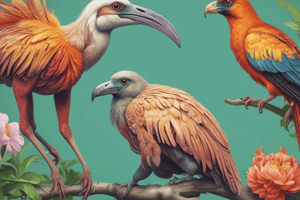Podcast
Questions and Answers
Define the biological species concept.
Define the biological species concept.
Scientists categorize organisms into species based on their physical, genetic, and behavioral characteristics. The biological species concept defines a species as a population of organisms that can interbreed to produce viable, fertile offspring.
List alternative species concepts.
List alternative species concepts.
Morphological, phylogenetic, and ecological species concepts.
Explain the role of reproductive isolation in the evolution of species.
Explain the role of reproductive isolation in the evolution of species.
Reproductive isolation occurs when part of a population becomes isolated from its parent population, leading to independent mutation, genetic drift, and natural selection.
Distinguish between prezygotic and postzygotic barriers.
Distinguish between prezygotic and postzygotic barriers.
Distinguish between macroevolution and microevolution.
Distinguish between macroevolution and microevolution.
What is binomial nomenclature?
What is binomial nomenclature?
What is a clade?
What is a clade?
What is the ecological species concept?
What is the ecological species concept?
What is gametic isolation?
What is gametic isolation?
Define habitat in the context of species.
Define habitat in the context of species.
What is a hybrid?
What is a hybrid?
What is hybrid breakdown?
What is hybrid breakdown?
What is mechanical isolation?
What is mechanical isolation?
What is a monophyletic group?
What is a monophyletic group?
What does the morphological species concept emphasize?
What does the morphological species concept emphasize?
What does the phylogenetic species concept emphasize?
What does the phylogenetic species concept emphasize?
Define population in biological terms.
Define population in biological terms.
What is a postzygotic barrier?
What is a postzygotic barrier?
What is a prezygotic barrier?
What is a prezygotic barrier?
Flashcards are hidden until you start studying
Study Notes
Biological Species Concept
- Defines species as populations that can interbreed to produce viable, fertile offspring.
- Prioritizes physical, genetic, and behavioral characteristics for classification.
Alternative Species Concepts
- Includes morphological, phylogenetic, and ecological species concepts.
- Each concept highlights different criteria for defining species but is less commonly used than the biological species concept.
Reproductive Isolation
- Occurs when part of a population becomes isolated, leading to independent evolution through mutation, genetic drift, and natural selection.
- Over time, isolated populations may develop reproductive barriers.
Prezygotic vs. Postzygotic Barriers
- Prezygotic barriers: Prevent mating or fertilization (e.g., behavioral differences, mechanical incompatibility).
- Postzygotic barriers: Impact offspring after fertilization (e.g., hybrids may be sterile or inviable).
- Both types contribute to genetic isolation and speciation.
Macroevolution vs. Microevolution
- Macroevolution: Evolutionary changes that produce new species from common ancestors.
- Microevolution: Small adaptations within a species that do not lead to the formation of new species.
Binomial Nomenclature
- Developed by Carl Linnaeus, system names species with two parts: genus and species.
Clade
- A group that includes a common ancestor and all of its descendants.
- Represents a branch on a phylogenetic tree.
Ecological Species Concept
- Defines species based on ecological niche and role in the ecosystem.
Gametic Isolation
- A prezygotic reproductive barrier where sperm and eggs are incompatible, preventing fertilization.
Habitat
- The ecological area where a species lives, survives, and reproduces.
Hybrid
- An offspring resulting from mating between individuals of different species.
Hybrid Breakdown
- F1 hybrids can reproduce, but F2 offspring are typically infertile.
Mechanical Isolation
- A prezygotic barrier due to physical incompatibility in reproductive structures.
Monophyletic Group
- A group of species that all descended from a common ancestor.
Morphological Species Concept
- Emphasizes structural features for determining species and common ancestry.
Phylogenetic Species Concept
- Focuses on genetic characteristics to identify species and their common ancestry.
Population
- A group of individuals from the same species residing in a specific area.
Postzygotic Barrier
- A barrier preventing successful reproduction where fertilization occurs but leads to infertile or non-viable offspring.
Prezygotic Barrier
- Encompasses various forms of reproductive isolation preventing mating, including behavioral and mechanical barriers.
Studying That Suits You
Use AI to generate personalized quizzes and flashcards to suit your learning preferences.




